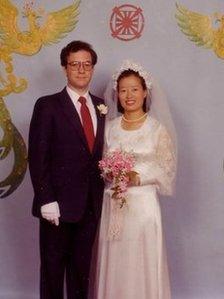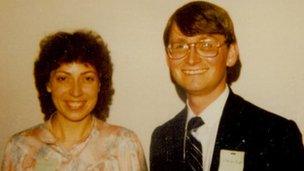Moon wedding: Getting married with 4,000 others
- Published
Archive video footage shows the 2,000 couples taking their vows
Exactly 30 years ago, 2,000 couples took part in a mass wedding in New York City. The event was organised by the Reverend Sun Myung Moon, founder of the Unification Church, who matched many of the brides and grooms himself.
When Philip Shanker and his Korean bride Kim Hye-shik walked down the aisle, in many ways they were just like any other couple - excited about their special day and about spending the rest of their lives together.
But there were also some big differences - their marriage was arranged by a religious leader and it was taking place alongside thousands of other couples.
"I always like to say I had a garden wedding with a few friends. Of course, the garden was Madison Square Garden and we had about 4,000 friends there," Shanker says.
He is a member of the Unification Church and a follower of the teachings of the Reverend Sun Myung Moon.

Philip Shanker and his wife lacked a common language
Often referred to as Moonies - a term some church members find offensive - they allow their 92-year-old Korean leader, whom they believe is the messiah, to choose their partners and then to marry them at a mass blessing ceremony with thousands of other couples.
"It is our tradition and it is important for each couple to be part of this ceremony, first because it is officiated by our true parents, father and mother Moon, and second because it is a global statement about the centrality of marriage and family," Shanker explains.
Shanker was 35 years old and had already been a member of the religion for 10 years when Moon chose a woman in Korea to be his bride.
"I aspired to an inter-racial marriage because it appealed to me to create a cross-cultural relationship as an instrument for bringing the world together. That is a strong principle that we are raised with in the movement," he explains.
Usually the elderly Korean picks couples in matching ceremonies in which hundreds of faithful wait for him to point to them and then to their future spouse.
In Shanker's case, he and his future wife lived in different countries, so they were just handed photographs of each other. Shanker says they both trusted their spiritual leader's decision and after meeting in Korea for a few weeks, they decided to go ahead with the marriage.
First they had to overcome a massive language barrier, since neither spoke each other's language. They also encountered vast cultural differences, including the fact that his wife was from a small rural farming village steeped in local traditions.
"My wife's mother was against the match. She told her that even a cripple would be better than a foreigner!" Shanker recalls, laughing.
It would be two years from the time they were matched before they lived together. The couple had to wait for her visa to the United States, while both continued to carry out the work of the church, bringing in new recruits and fundraising by selling flowers and sweets on the street.
Finally, they moved in together in New York City but they still slept in separate beds, sticking to the rules of their faith and remaining virgins while they waited for the day of their wedding. It would be another two years until that day arrived.
"It was tough to be close to each other without being intimate," says Shanker.
Finally, four years after they were matched, the big day was announced. Two thousand couples from at least 12 different countries poured into Manhattan along with thousands of their family and friends.
One of the grooms was 27-year-old Canadian Gordon Neufeld, who had become involved with the church six years earlier.
Both Neufeld and Shanker were young graduates feeling lost and confused when they were recruited by the church. In each case they were approached and invited to attend talks at a commune. Both thought it was a hippy commune and it was several weeks before there was any mention of the Unification Church or the Reverend Sun Myung Moon.
At the time Neufeld was an agnostic, perhaps even an atheist, he says. But after just four weeks of living in the commune he became convinced that Moon was the messiah and embraced the church's central principle that if everyone in the world was converted, heaven on earth would be achieved.
"They were such nice people and I didn't want to be rude. I thought I would put my doubts to one side for a while and just go with it and eventually I forgot those doubts," says Neufeld.
Six years after he joined the church he was paired with Erica Jenner, an English woman who had flown to America for the matching ceremony. They spent an afternoon and evening getting to know each other before she flew back to the United Kingdom. They had to wait two years for their wedding.
As the big day approached, Manhattan prepared for the thousands of couples to descend on the city. Dentists and barbers offered cheap rates for brides and grooms, while many restaurants advertised "newly-weds" meal deals.
The 2,000 couples, all wearing the same white dresses and blue suits with red ties, lined up and marched into the arena in Madison Square Garden. As they entered they were sprinkled with water by Moon and his wife.
Speaking in Korean, the leader of the church read out the marriage vows and, after they had heard a translation, the brides and grooms affirmed their consent by shouting in unison: "Yes father!"
Finally, after years of waiting, Neufeld and Shanker had married their brides. But unlike most newlyweds, they didn't rush off to consummate their union.
"Part of our tradition is that we wait for 40 days after the wedding, it is a period of time we offer to God to sanctify the marriage," says Shanker.

Erica Jenner and Gordon Neufeld never lived together
But Neufeld says he was asked to wait far longer and to carry out a number of tasks.
"In most cases we were expected to wait around three years and recruit three new members before we could be together," he says.
Neufeld's marriage didn't last. A few years after they were married, Jenner, who was still in the UK, lost her faith and left the church.
Neufeld was devastated. But about four years later he too found that he couldn't continue with the religion.
Walking away was far from easy, though.
"It was extremely frightening and difficult. I worried that I would be entering a spiritual void. I felt empty and lost," he says.
Now remarried, he lives in New York state where he works as a bookseller and freelance writer.
Shanker had a very different experience. Although he admits that his marriage was far from easy, he says it was a committed relationship.
His wife died suddenly from a stroke a few years ago but in the last decade of their marriage, he says they reached a new kind of harmony in their relationship.
"Marriage and family is really the Unification Church's spiritual path and whatever maturity I have achieved in my life has been through being someone's husband and someone's father."
Shanker has made his career in the faith and is now the Director of the Blessed Life Ministry of the Church.
He estimates that about 75% of the couples who were married in 1982 are still together. This is higher than the average in the US, where 50% of marriages end in divorce.
But Gordon Neufeld believes that the 75% figure is suspect - and could, for example, include people who divorced and remarried.
Whatever the success rate of the arranged marriages, they have remained popular. Since that wedding in 1982, tens of thousands of people have been married in the same way, including some of Philip Shanker's own children.
<italic>Gordon Neufeld and Philip Shanker spoke to Chloe Hadjimatheou for </italic> <link> <caption>Witness</caption> <altText>BBC World Service Witness</altText> <url href="http://www.bbc.co.uk/programmes/p004t1hd" platform="highweb"/> </link> <italic> on the</italic> <link> <caption> BBC World Service</caption> <url href="http://www.bbc.co.uk/worldservice" platform="highweb"/> </link>